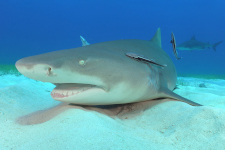Negaprion brevirostris
(Poey, 1868)
Lemon shark
Classification: Elasmobranchii Carcharhiniformes Carcharhinidae
Reference of the original description
Synopsis piscium cubensium. Catalogo razonado de los peces de la isla de Cuba. Repertorio Fisico–Natural de la Isla de Cuba, 2: 279–484
Synopsis piscium cubensium. Catalogo razonado de los peces de la isla de Cuba. Repertorio Fisico–Natural de la Isla de Cuba, 2: 279–484
Image of the original description
No image in first description.
No image in first description.
Synonyms / new combinations and misspellings
Carcharhinus brevirostris, Carcharias brevirostris, Hypoprion brevirostris, Negaprion aff. brevirostris, Negaprion cf. brevirostris, Negaprion (Hypoprion) brevirostris
Carcharhinus brevirostris, Carcharias brevirostris, Hypoprion brevirostris, Negaprion aff. brevirostris, Negaprion cf. brevirostris, Negaprion (Hypoprion) brevirostris
Description :
Citation: Negaprion brevirostris (Poey, 1868): In: Database of modern sharks, rays and chimaeras, www.shark-references.com, World Wide Web electronic publication, Version 12/2025
Please send your images of "Negaprion brevirostris" to info@shark-references.com

Negaprion brevirostris (Poey, 1868), © Albert Kok, wiki

Negaprion brevirostris (Poey, 1868), © Albert Kok, wiki
Common names
 Kurznasenhai,
Kurznasenhai,  Zitronenhai,
Zitronenhai,  Galano,
Galano,  Galano de ley,
Galano de ley,  Limón,
Limón,  Tiburón amarillo,
Tiburón amarillo,  Tiburón galano,
Tiburón galano,  Tiburón limón,
Tiburón limón,  Requin citron,
Requin citron,  Requin limon,
Requin limon,  Requin-citron,
Requin-citron,  Lemon shark,
Lemon shark,  Requiem shark,
Requiem shark,  Squalo limone,
Squalo limone,  Cacao-limao,
Cacao-limao,  Tubarao-limao
Tubarao-limao
 Kurznasenhai,
Kurznasenhai,  Zitronenhai,
Zitronenhai,  Galano,
Galano,  Galano de ley,
Galano de ley,  Limón,
Limón,  Tiburón amarillo,
Tiburón amarillo,  Tiburón galano,
Tiburón galano,  Tiburón limón,
Tiburón limón,  Requin citron,
Requin citron,  Requin limon,
Requin limon,  Requin-citron,
Requin-citron,  Lemon shark,
Lemon shark,  Requiem shark,
Requiem shark,  Squalo limone,
Squalo limone,  Cacao-limao,
Cacao-limao,  Tubarao-limao
Tubarao-limao
Short Description
A brownish shark with yellow overtones but no conspicuous markings. Large second dorsal fin nearly same size as first dorsal [17659].
A brownish shark with yellow overtones but no conspicuous markings. Large second dorsal fin nearly same size as first dorsal [17659].
Distribution
Western Atlantic: New Jersey, USA to southern Brazil, including the Gulf of Mexico, the Bahamas, and the Caribbean; also in Gulf of Mexico [17659]. Northeast Atlantic: Senegal, Côte d"quot;Ivoire and probably wide-ranging off West Africa, but this requires confirmation. Eastern Pacific: southern Baja California, Mexico and the Gulf of California to Ecuador. Source: www.gbif.org
Western Atlantic: New Jersey, USA to southern Brazil, including the Gulf of Mexico, the Bahamas, and the Caribbean; also in Gulf of Mexico [17659]. Northeast Atlantic: Senegal, Côte d"quot;Ivoire and probably wide-ranging off West Africa, but this requires confirmation. Eastern Pacific: southern Baja California, Mexico and the Gulf of California to Ecuador. Source: www.gbif.org
Human uses
fisheries: commercial; gamefish: yes
fisheries: commercial; gamefish: yes
Biology
Distinct pairing with embrace [17086]. Viviparous, placental [733], with 5 to 17 embryos (Ref. 9253). Both male and female during precopulatory and courtship swim with body axes in parallel (Ref. 49562, 51112). During copulation, the pair performs coordinated swimming (Ref. 49562, 51112). Exhibits no pattern of periodicity. Feeding is asynchronous and intermittent. Daily ration is estimated at 1.5 - 2.1% body weight per day; meal completely evacuated from stomach 25-41 hr after feeding, depending on meal type and temperature; fecal production continues for 68-82 hr after feeding (Wetherbee 1990).
Distinct pairing with embrace [17086]. Viviparous, placental [733], with 5 to 17 embryos (Ref. 9253). Both male and female during precopulatory and courtship swim with body axes in parallel (Ref. 49562, 51112). During copulation, the pair performs coordinated swimming (Ref. 49562, 51112). Exhibits no pattern of periodicity. Feeding is asynchronous and intermittent. Daily ration is estimated at 1.5 - 2.1% body weight per day; meal completely evacuated from stomach 25-41 hr after feeding, depending on meal type and temperature; fecal production continues for 68-82 hr after feeding (Wetherbee 1990).
Size / Weight / Age
340 cm TL (male/unsexed; [17659]); max. published weight: 183.7 kg (Ref. 40637); max. reported age: 25 years [2246]
340 cm TL (male/unsexed; [17659]); max. published weight: 183.7 kg (Ref. 40637); max. reported age: 25 years [2246]
Remarks
shark-references Species-ID=4087;
shark-references Species-ID=4087;
Parasites (arranged by Jürgen Pollerspöck)
Monogenea
Cestoda
Copepoda
Hirudinea
Monogenea
- Dermophthirius nigrellii Cheung & Ruggieri, 1983 [5987] [20260]
- Heteronchocotyle hypoprioni Brooks, 1934 [17150]
- Neodermophthirius harkemai Price, 1963 [19880] [17205] [6111]
Cestoda
- Anthobothrium laciniatum Linton, 1890 [16171]
- Callitetrarhynchus gracilis (Rudolphi, 1819) Pintner, 1931 [16112]
- Callitetrarhynchus speciosus (Linton, 1897) Carvajal & Rego, 1985 [16171] [16112]
- Cylindrophorus hypoprioni (Potter, 1937) [16370] [16171] [7384]
- Dasyrhynchus giganteus (Diesing 1850) Pintner 1929 [16304] [5977] [16112]
- Dasyrhynchus variouncinatus (Pintner, 1913) [16112]
- Floriceps caballeroi Cruz, 1977 [23771]
- Floriceps saccatus Cuvier, 1817 [16112]
- Otobothrium penetrans Linton, 1907 [16112]
- Phoreiobothrium anticaporum Caira, Richmond & Swanson, 2005 [16205]
- Phoreiobothrium lasium Linton, 1889 [16171]
- Phyllobothrium dasybati Yamaguti, 1934 [16171]
- Phyllobothrium lactuca Van Beneden, 1850 [16171]
- Platybothrium harpago (Euzet, 1953) Healy, 2003 [16307] [7384]
- Poecilancistrium caryophyllum (Diesing, 1850) Dollfus, 1929 [16112]
- Pseudogrillotia perelica (Shuler, 1938) [16171] [16112]
- Scyphophyllidium roberti (Ruhnke & Thompson, 2006) [16104]
- Tentacularia insignis (Linton, 1924) [16171]
Copepoda
- Alebion carchariae Krøyer, 1863 [16589]
- Kroyeria spatulata Pearse, 1948 [16589] [17867] [34815]
- Nemesis pilosus Pearse, 1951 [16589]
- Nesippus orientalis Heller, 1868 [16589]
- Pandarus sinuatus Say, 1818 [16599] [16589]
- Paralebion elongatus Wilson, 1911 [16589]
- Perissopus dentatus Steenstrup & Lütken, 1861 [16589]
Hirudinea
- Pontobdella macrothela (Schimarda, 1861) [25688]




















